The Arctic fox’s ability to regulate temperature is crucial for survival. This manual explores their unique physiological and behavioral strategies to thrive in the harsh‚ cold Arctic environment.
Overview of Arctic Fox Physiology
The Arctic fox’s physiology is tailored for extreme cold. Their thick‚ layered fur and blubber provide exceptional insulation‚ while their compact body minimizes heat loss. Efficient blood circulation ensures warmth is retained‚ and their small ears and tail reduce exposure. Metabolic rate adjustments help conserve energy‚ and a unique countercurrent heat exchange system in their legs prevents icy ground from siphoning heat. These adaptations enable them to survive in temperatures as low as -58°F (-50°C)‚ making them one of the most cold-resilient mammals on Earth. Their physiology is a testament to evolutionary specialization‚ ensuring survival in harsh Arctic conditions.
Importance of Temperature Regulation in Arctic Environments
Temperature regulation is vital for Arctic foxes to survive the extreme‚ frigid conditions of their habitat. The Arctic environment‚ characterized by long‚ harsh winters and short summers‚ demands precise physiological and behavioral adaptations. Without effective temperature regulation‚ the foxes would lose heat rapidly‚ leading to hypothermia and death. Their ability to maintain a stable body temperature ensures proper metabolic function‚ energy conservation‚ and overall survival. This adaptation is crucial for hunting‚ reproducing‚ and thriving in one of Earth’s most inhospitable regions. Efficient temperature control allows Arctic foxes to exploit their ecological niche‚ making them a key component of the Arctic ecosystem. Their survival hinges on this critical biological function‚ underscored by the challenges posed by climate change and habitat alterations.
Objective of the Manual
This manual aims to provide a comprehensive understanding of Arctic fox temperature control mechanisms‚ adapting to their harsh Arctic habitat. It outlines the physiological‚ behavioral‚ and environmental strategies they employ to regulate body temperature. The objective is to serve as a detailed guide for researchers‚ biologists‚ and enthusiasts‚ offering insights into their survival adaptations. The manual covers key topics such as fur insulation‚ metabolic adjustments‚ and denning behaviors. It also explores the impact of climate change and human activity on their temperature regulation. By examining these aspects‚ the manual seeks to enhance understanding and appreciation of Arctic foxes’ unique adaptations. It further highlights the importance of conservation efforts to protect these resilient creatures in the face of environmental challenges.

Physical Adaptations for Temperature Control
Arctic foxes possess thick fur layers‚ blubber reserves‚ and a compact body structure‚ all designed to minimize heat loss and maintain core temperature in freezing conditions effectively.
Thick Fur Layers and Their Role in Insulation
Arctic foxes are equipped with a unique dual-layer fur coat‚ consisting of a dense undercoat and a longer‚ guard hair layer. This remarkable adaptation traps warm air close to the skin‚ effectively insulating the fox from extreme cold. The undercoat is particularly thick during winter‚ providing exceptional thermal protection. The fur’s insulation properties are further enhanced by its white color‚ which blends seamlessly with snowy environments‚ reducing heat loss through visibility. This natural insulation system allows the Arctic fox to maintain a stable core temperature without expending excessive energy. The fur layers are a critical component of their temperature control strategy‚ ensuring survival in the harsh Arctic climate. This adaptation is vital for their ability to thrive in one of the coldest habitats on Earth.
Blubber and Fat Reserves
Arctic foxes rely on substantial blubber and fat reserves to maintain energy and regulate body temperature. These fat layers act as an additional insulation source‚ reducing heat loss during extreme cold. The blubber layer‚ particularly thick in winter‚ stores energy‚ which is vital for survival when food is scarce. Fat reserves are metabolized to generate heat‚ ensuring the fox’s core temperature remains stable. This physiological adaptation complements their fur coats‚ creating a dual defense against cold. The efficient storage and use of fat enable Arctic foxes to survive prolonged periods without food‚ making them well-suited to their challenging Arctic environment. This energy-efficient mechanism is crucial for their overall thermoregulation strategy‚ enhancing their ability to endure harsh winter conditions effectively.
Compact Body Structure to Minimize Heat Loss
The Arctic fox’s compact body structure is a key adaptation for minimizing heat loss. Their small size and rounded shape reduce the surface-to-volume ratio‚ which helps retain heat more efficiently. They often tuck their limbs close to their body and curl up when resting‚ further reducing exposed areas. This physical adaptation is crucial in the freezing Arctic environment‚ allowing them to conserve energy and maintain a stable core temperature. The combination of a compact body and thick fur ensures they can withstand harsh winter conditions effectively. This structural efficiency is vital for their survival‚ enabling them to thrive in one of the coldest habitats on Earth.
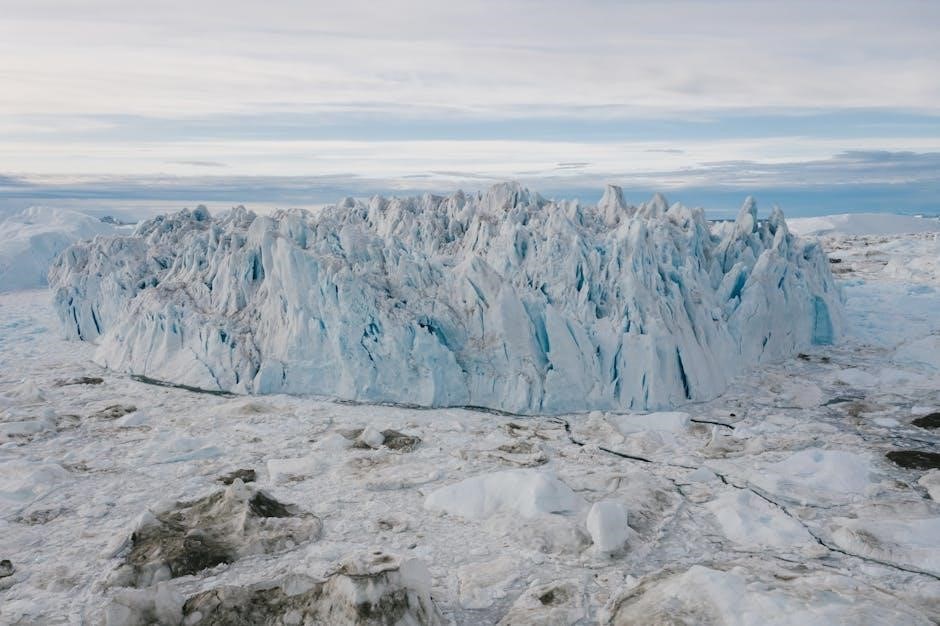
Behavioral Strategies for Temperature Regulation
Arctic foxes employ behaviors like burrowing‚ huddling‚ and limiting activity to conserve heat and adapt to extreme cold‚ ensuring survival in freezing Arctic conditions effectively.
Burrowing and Denning Behavior
Arctic foxes dig burrows and dens to escape harsh winds and extreme cold‚ creating insulated shelters. These underground sites provide thermal protection‚ maintaining a stable temperature. Snow cover further enhances insulation‚ reducing heat loss. Dens are often reused or shared‚ emphasizing their importance for survival. This behavior minimizes energy expenditure‚ crucial during frigid Arctic winters. The use of burrows also shields them from predators‚ adding another layer of protection. By burrowing‚ Arctic foxes effectively adapt to their environment‚ ensuring thermoregulation and safety. This strategy is vital for their ability to thrive in one of Earth’s coldest ecosystems.
Group Huddling to Share Body Heat
Group huddling is a critical behavioral strategy for Arctic foxes to conserve heat in extreme cold. By gathering in groups‚ they reduce exposure to harsh winds and share body heat. This communal behavior minimizes heat loss‚ as their combined body warmth creates a more stable microclimate. Arctic foxes often curl up together‚ reducing the surface area exposed to cold. This energy-saving tactic is particularly vital during periods of food scarcity or intense cold snaps. Huddling also strengthens social bonds and enhances survival chances. It is a testament to their adaptability‚ ensuring they maintain core body temperature without excessive metabolic exertion. Such collective behavior highlights their resilience in the unforgiving Arctic environment‚ where every strategy counts for survival.
Limiting Activity During Extreme Cold
During extreme cold‚ Arctic foxes reduce their activity levels to conserve energy and maintain body heat. This strategy minimizes heat loss and prevents excessive energy expenditure. By remaining still or moving only when necessary‚ they avoid unnecessary exposure to harsh winds and cold. This behavior is particularly crucial when temperatures drop significantly‚ as it helps them preserve their fat reserves. Limiting activity also allows them to rely on stored energy rather than expending it on movement. This adaptation is vital for survival in the Arctic‚ where extreme cold can quickly deplete energy reserves. By staying inactive‚ Arctic foxes efficiently manage their thermoregulatory needs‚ ensuring they remain warm and conserve vital resources for essential functions.
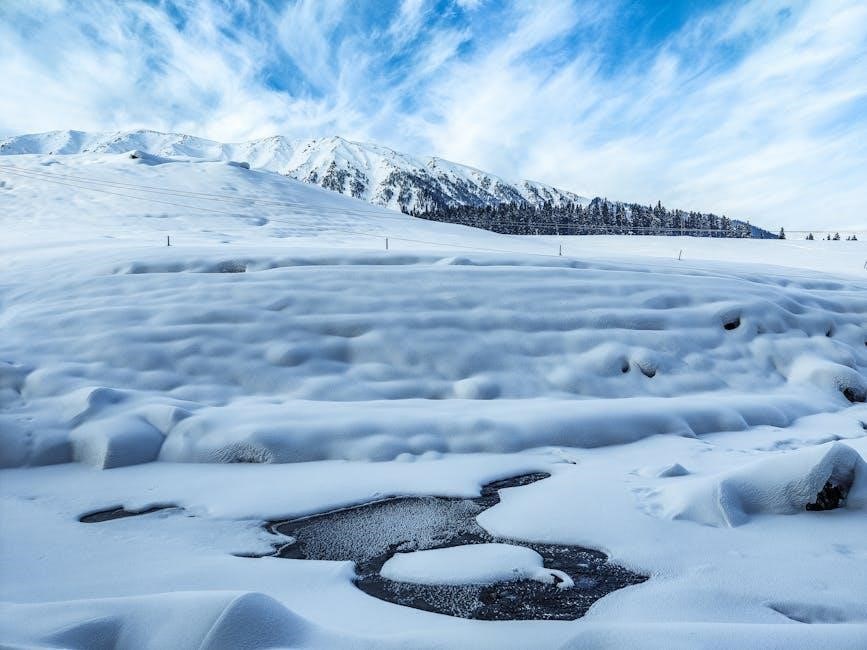
Physiological Mechanisms
Arctic foxes employ efficient circulation‚ metabolic adjustments‚ and countercurrent heat exchange to maintain body temperature in freezing environments‚ ensuring optimal thermoregulation without excessive energy expenditure.
Efficient Circulation and Blood Flow
Arctic foxes maintain thermal stability through specialized blood flow mechanisms. Their circulatory system minimizes heat loss by reducing blood flow to extremities in extreme cold‚ conserving core warmth. This adaptation ensures efficient energy use while protecting vital organs from hypothermia. The countercurrent heat exchange system in their legs and paws further enhances heat retention‚ allowing them to survive in subzero temperatures. These physiological strategies are crucial for their Arctic habitat‚ demonstrating remarkable evolutionary adaptations to harsh‚ cold environments. Efficient circulation and blood flow are key components of their temperature control mechanisms‚ enabling them to thrive where other species would succumb to the cold.
Metabolic Rate Adjustments
Arctic foxes regulate their metabolic rates to conserve energy and maintain body heat in cold environments. During extreme cold‚ their metabolism slows down to reduce energy expenditure‚ while still generating enough heat to sustain vital functions. This adjustment ensures they can survive prolonged periods without food‚ relying on stored fat reserves. Their metabolic flexibility allows them to adapt to fluctuating temperatures‚ optimizing energy use based on environmental conditions. This physiological adaptation is crucial for their survival‚ enabling them to thrive in the harsh Arctic climate where energy conservation is essential. By fine-tuning their metabolic rates‚ Arctic foxes efficiently balance heat production and energy preservation‚ ensuring their survival in one of the coldest habitats on Earth.
Countercurrent Heat Exchange Systems
Arctic foxes utilize countercurrent heat exchange systems to minimize heat loss in their extremities. This system involves the arrangement of arteries and veins in close proximity‚ allowing warm arterial blood to transfer heat to cold venous blood returning from the limbs. This efficient exchange ensures that heat is conserved and not lost to the environment‚ maintaining core body temperature. This adaptation is particularly vital in the Arctic fox’s paws and ears‚ where heat loss is most significant. By retaining heat in these areas‚ the fox reduces the risk of frostbite and maintains overall thermal balance. This physiological mechanism is a critical component of their ability to survive in extremely cold climates‚ ensuring energy conservation and thermal stability. It is a testament to their evolutionary adaptation to harsh Arctic conditions.
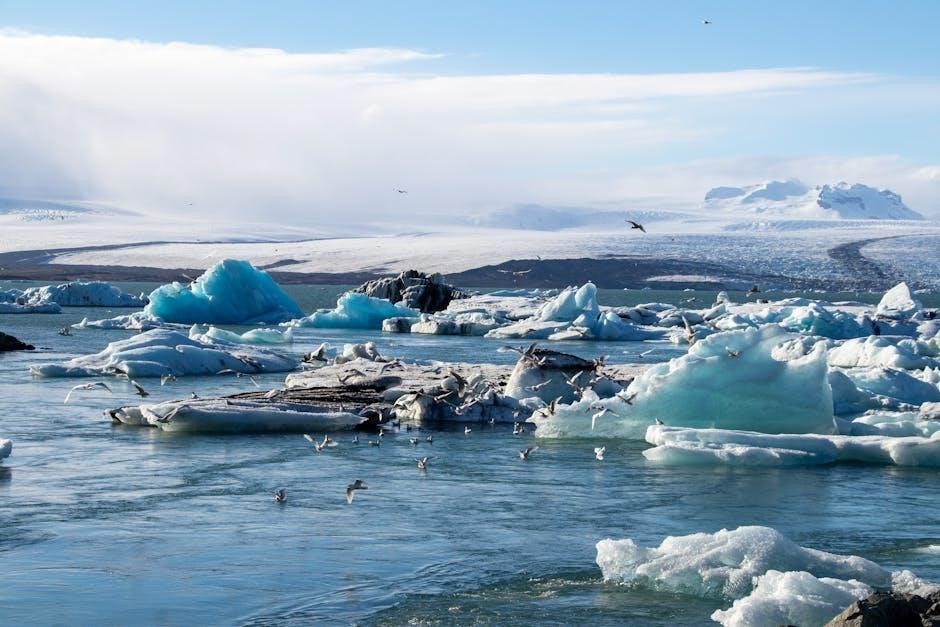
Diet and Nutrition in Cold Climates
Arctic foxes rely on a high-calorie diet rich in fat and protein to sustain energy in freezing environments. Their diet consists mainly of lemmings‚ birds‚ and carrion‚ essential for thermoregulation and survival.
High-Calorie Diet Composition
Arctic foxes require a high-calorie diet to maintain energy reserves for thermoregulation in extreme cold. Their diet is rich in fat and protein‚ primarily from small mammals like lemmings‚ birds‚ and carrion. The fat reserves are crucial for insulation and energy during food scarcity. They also consume eggs‚ berries‚ and occasionally‚ marine resources like seal carcasses. This diet composition ensures they can survive harsh Arctic winters‚ where metabolic demands are high. The calorie-dense food sources are essential for sustaining their bodily functions and adapting to the freezing environment. This dietary strategy is vital for their survival and temperature regulation in one of the coldest habitats on Earth.
Hunting Strategies in Snowy Conditions
Arctic foxes employ specialized hunting strategies to thrive in snowy environments. Their white fur provides camouflage‚ allowing them to sneak up on prey like lemmings and voles. They use acute hearing to detect movements under the snow and pinpoint prey locations. Once detected‚ they pounce‚ diving through the snow with precision. This “snow-diving” technique is highly effective in catching small mammals. Additionally‚ they hunt birds and their eggs‚ adapting their tactics to the availability of prey. Their ability to cache excess food ensures survival during periods of scarcity. These strategies are crucial for maintaining energy reserves‚ essential for thermoregulation and overall survival in the harsh Arctic climate.

Food Storage and Caching Behavior
Arctic foxes exhibit highly efficient food storage and caching behavior‚ crucial for survival in unpredictable environments. They bury excess prey‚ often in shallow pits or under snow‚ to create hidden caches. This behavior ensures a steady food supply during periods of scarcity. Cached food helps maintain energy reserves‚ essential for thermoregulation. Foxes use their keen memory to retrieve cached food‚ even under deep snow. Caching also reduces dependency on immediate hunting success‚ allowing them to conserve energy during harsh weather. This adaptability highlights their resourcefulness in exploiting available resources‚ ensuring survival in the Arctic’s challenging conditions.
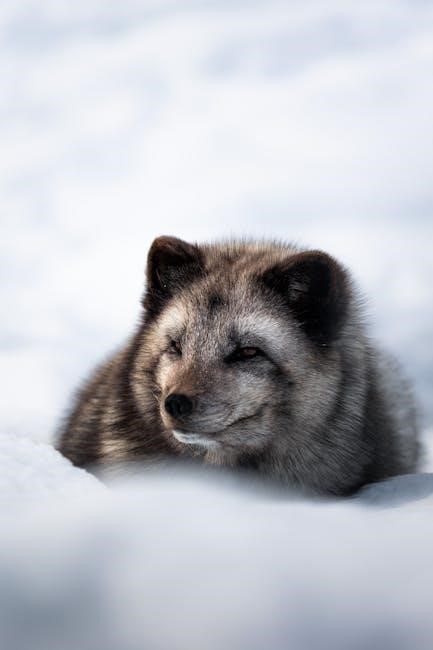
Habitat Utilization for Thermal Regulation
Arctic foxes strategically use wind-sheltered areas‚ snow cover‚ and migration patterns to regulate body temperature‚ ensuring efficient thermoregulation in their freezing Arctic habitat.
Selection of Wind-Sheltered Areas
Arctic foxes prioritize wind-sheltered areas to minimize heat loss in harsh Arctic conditions. These areas‚ such as snow-covered ridges or leeward slopes‚ provide natural protection from icy winds. By seeking out such locations‚ foxes reduce exposure to wind chill‚ which significantly increases heat loss. They often dig burrows or dens in these sheltered spots‚ further enhancing insulation. The dense snow cover in these areas acts as an additional layer of protection‚ maintaining a stable microclimate. This strategic habitat selection is crucial for conserving energy and maintaining body temperature in extreme cold. The ability to identify and utilize wind-sheltered areas highlights the Arctic fox’s remarkable adaptation to its freezing environment‚ ensuring survival during the harshest winter months.
Use of Snow Cover for Insulation
Snow cover plays a vital role in the Arctic fox’s thermoregulation. They use snow as a natural insulator‚ burrowing into drifts to escape extreme cold. The snow layer traps warm air close to their fur‚ reducing heat loss. This behavior is especially critical during intense cold snaps‚ providing a sheltered environment. The fox’s white fur also blends with the snow‚ aiding in camouflage. By utilizing snow cover‚ they maintain a stable body temperature without expending extra energy. This adaptation is essential for survival‚ demonstrating their evolutionary prowess in harsh Arctic conditions. The combination of snow insulation and behavioral strategies underscores their remarkable ability to thrive in one of the coldest ecosystems on Earth.
Migration Patterns in Response to Temperature Changes
Arctic foxes exhibit migratory behaviors to adapt to temperature fluctuations. They move between summer and winter habitats‚ seeking optimal conditions. During warmer months‚ they shift to higher latitudes or elevations where temperatures are cooler. In winter‚ they migrate to areas with more stable snow cover and abundant prey. This strategic movement helps them escape extreme cold and find food. Their migration patterns are closely linked to environmental changes‚ ensuring they remain in regions with favorable temperatures. This adaptability is crucial for their survival‚ as it allows them to balance energy expenditure and food availability throughout the year. By migrating‚ Arctic foxes effectively cope with the challenges posed by temperature variations in their Arctic habitat.
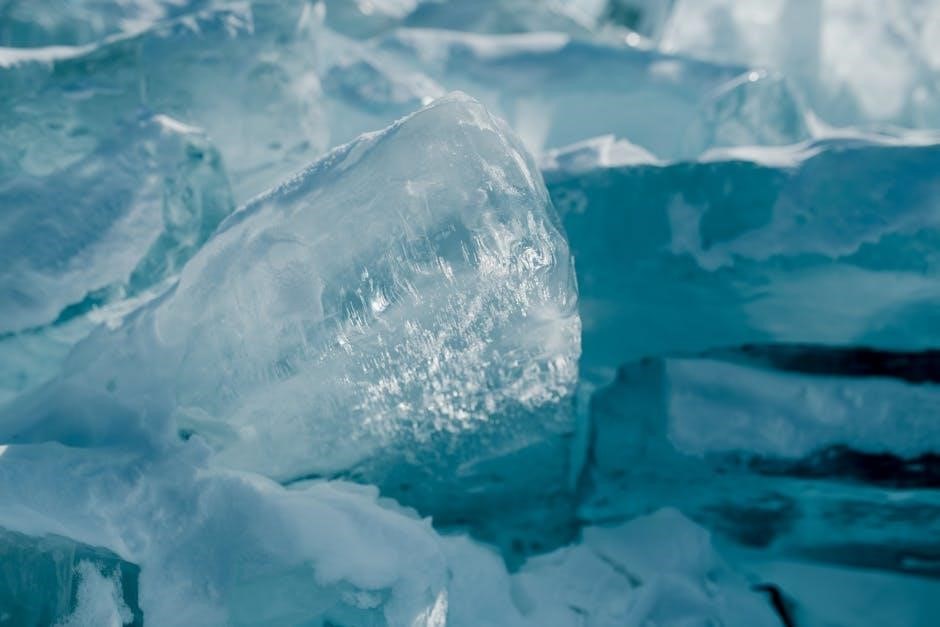
Reproductive Strategies
Arctic foxes employ reproductive strategies to ensure survival in harsh environments. They breed in spring‚ with litter sizes varying based on food availability‚ optimizing offspring survival chances.
Mating and Breeding Timing
Arctic foxes synchronize their mating and breeding with optimal environmental conditions. They typically mate in early spring‚ with breeding timed to ensure kits are born when food is abundant. This strategic timing maximizes survival rates‚ as the harsh Arctic winter subsides‚ and prey becomes more accessible. The breeding season lasts several weeks‚ allowing pairs to produce litters adapted to the upcoming summer. Female foxes exhibit delayed implantation‚ extending gestation to align birth with resource availability. This reproductive strategy ensures that neonatal kits thrive during the brief Arctic summer‚ when temperatures are relatively stable and food is plentiful. Such precise timing is critical for the species’ survival in one of Earth’s most extreme climates.
Denning Behavior During Gestation
Arctic foxes exhibit denning behavior during gestation to maintain stable temperatures. Females prepare dens in snowbanks or underground‚ lining them with fur and vegetation for insulation. These dens protect them from extreme cold‚ with temperatures inside remaining relatively constant. The den’s structure minimizes heat loss‚ crucial for energy conservation during pregnancy. This behavior ensures the developing kits are exposed to stable conditions‚ promoting healthy growth. The den also shields the fox from harsh winds and predators‚ creating a safe environment for the vulnerable period of gestation. Such adaptive denning is vital for reproductive success in the Arctic’s unforgiving climate.
Thermoregulation in Neonatal Kits
Neonatal Arctic fox kits rely heavily on their mother for thermoregulation‚ as they are born underdeveloped and lack the ability to generate heat independently. The den provides a stable‚ warm environment‚ maintaining temperatures that support their survival. Kits cluster together to reduce heat loss‚ while their thick fur‚ which begins to develop early‚ aids in retaining body heat. The mother’s presence ensures constant warmth‚ and her fur acts as additional insulation. As they grow‚ kits develop a higher metabolic rate to generate heat. This combination of behavioral and physiological adaptations ensures neonatal kits can thrive in the Arctic’s extreme cold‚ despite their vulnerability at birth.
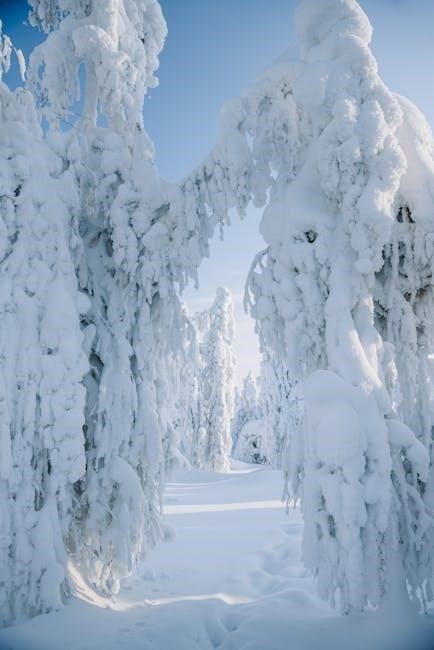
Human Impact on Arctic Fox Temperature Control
Climate change alters Arctic habitats‚ affecting foxes’ prey availability and denning sites. Human activities disrupt thermoregulation‚ while conservation efforts aim to mitigate these impacts and protect populations.
Climate Change Effects on Habitats
Climate change significantly impacts Arctic fox habitats by reducing sea ice and altering prey distribution. Rising temperatures lead to habitat fragmentation‚ making it harder for foxes to adapt. Warmer conditions also increase the prevalence of parasites and diseases‚ further threatening their survival. Additionally‚ changes in snow cover disrupt their ability to hunt and shelter effectively. These environmental shifts force Arctic foxes to compete with other predators‚ such as red foxes‚ for limited resources. Conservation efforts must address these habitat changes to ensure the species’ resilience in a rapidly warming Arctic ecosystem.
Impact of Human Activity on Denning Sites
Human activities‚ such as mining‚ construction‚ and tourism‚ increasingly encroach on Arctic fox denning sites; This disturbance disrupts their sensitive nesting areas‚ leading to reduced reproductive success. Noise pollution from machinery and vehicles also stresses the foxes‚ causing them to abandon dens. Habitat fragmentation due to infrastructure development further isolates populations‚ making it harder for them to find suitable denning locations. Additionally‚ climate change exacerbates these impacts by altering the availability of sheltered spots. Protecting denning sites is critical to preserving Arctic fox populations and requires stricter regulations and public awareness campaigns to mitigate human-induced disturbances.
Conservation Efforts for Arctic Foxes
Conservation efforts for Arctic foxes focus on protecting their habitats and reducing human impact. International agreements‚ such as the Arctic Council’s initiatives‚ aim to preserve their ecosystems. Habitat restoration projects rebuild damaged denning sites‚ ensuring safe breeding grounds. Education campaigns raise awareness about the importance of minimizing disturbances near fox habitats. Research programs monitor fox populations and study the effects of climate change. Collaborative efforts between governments‚ NGOs‚ and local communities are essential for effective conservation. These measures aim to safeguard the Arctic fox’s ability to adapt and thrive in their challenging environment.

Future Implications and Research Directions
Research on Arctic fox temperature control will focus on climate change impacts and adaptation strategies. Advanced monitoring technologies and international collaborations will enhance conservation and survival studies.
Adaptation to Warming Environments
As Arctic temperatures rise‚ foxes must adapt to reduced ice cover and shifting prey distributions. Researchers are studying genetic and behavioral changes to understand their resilience. New strategies‚ like diet diversification‚ are emerging as critical for survival. Conservation efforts focus on protecting habitats and reducing human impact. Technological advancements in monitoring will aid in tracking these adaptations‚ ensuring effective support for Arctic fox populations in a warming world.
Technological Advances in Monitoring
Advancements in technology have revolutionized the monitoring of Arctic foxes‚ enabling precise tracking of their physiological responses to temperature changes. GPS collars and thermal imaging cameras provide real-time data on their movements and heat regulation. Sensor-equipped dens monitor microclimates‚ offering insights into energy conservation strategies. Machine learning algorithms analyze large datasets to predict behavioral shifts due to climate change. These tools enhance conservation efforts by identifying vulnerable populations and informing habitat protection strategies. Such innovations are crucial for understanding Arctic foxes’ adaptability and ensuring their survival in a rapidly changing environment.
Collaborative Conservation Initiatives
Collaborative efforts are essential for protecting Arctic foxes and their habitats. International partnerships between scientists‚ policymakers‚ and conservation organizations are critical for addressing climate change impacts. Data-sharing platforms and joint research projects enable a unified approach to understanding and mitigating threats; Local communities are also engaged in monitoring and protecting fox populations‚ ensuring sustainable practices. Such initiatives foster a holistic strategy‚ combining scientific insights with on-the-ground actions to safeguard Arctic foxes. These collaborative efforts are vital for ensuring the long-term survival of this adapted species in a rapidly changing Arctic environment.